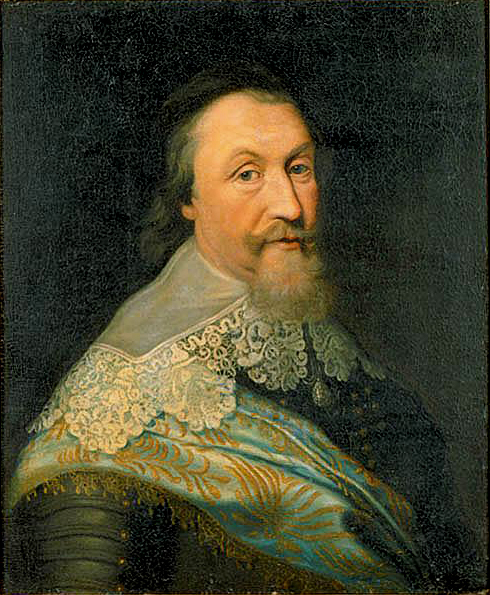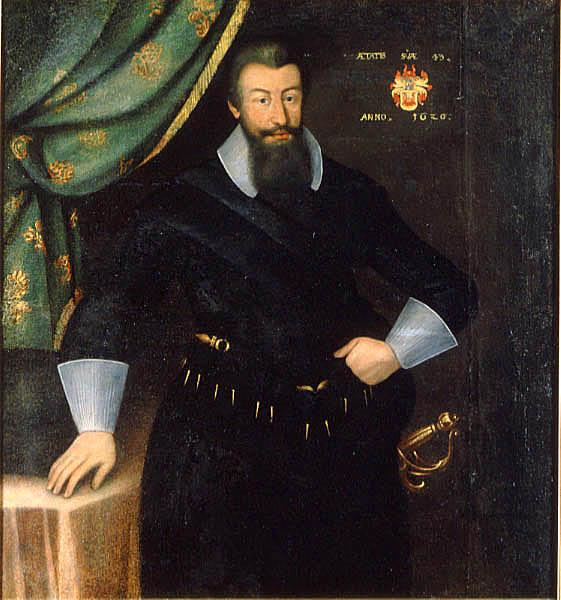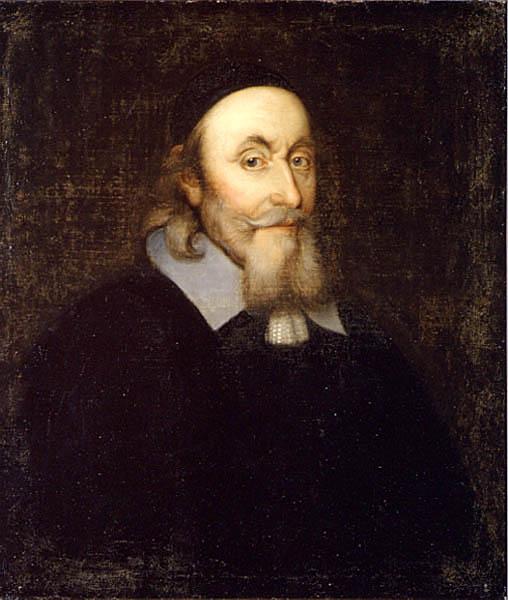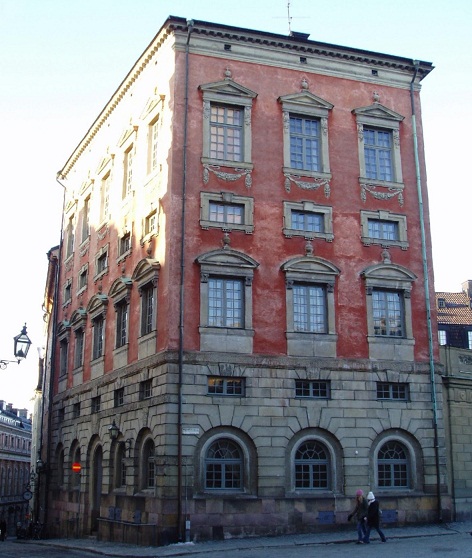<Back to Index>
- Mathematician Julius Plücker, 1801
- Painter John Linnell, 1792
- Lord High Chancellor of Sweden Axel Gustafsson Oxenstierna af Södermöre, 1583
PAGE SPONSOR


Axel Gustafsson Oxenstierna af Södermöre (June 16, 1583 – August 28, 1654), Count of Södermöre, was a Swedish statesman. He became a member of the Privy Council in 1609 and served as Lord High Chancellor of Sweden from 1612 until his death. He was a confidant of both Gustavus Adolphus and later Queen Christina.
Oxenstierna is widely considered one of the most influential people in Swedish history. He played an important role during the Thirty Years' War and was appointed Governor-General of occupied Prussia; he also laid the foundations of Swedish central government administration.
Oxenstierna was born on June 16, 1583, at Fånö in Uppland, the son of Gustaf Gabrielsson Oxenstierna (1551 - 1597) and Barbro Axelsdotter Bielke (1556 - 1624). He was the oldest of nine siblings. After the death of her husband Gustaf, Axel's mother Barbro decided to let Axel and his brothers Christer and Gustaf finish their studies abroad. Thus, the brothers received their education at the universities of Rostock, Wittenberg and Jena. On returning home in 1603 he took up an appointment as kammarjunkare to King Charles IX of Sweden.
In 1606 he undertook his first diplomatic mission, to Mecklenburg and other German royal courts. While on diplomatic duty abroad, Oxenstierna gained appointment to the Privy Council (Riksrådet). Henceforth, Oxenstierna became one of the king's most trusted servants. In 1609 he travelled to Reval (present day Tallinn) to, on King Charles's behalf, receive tributes from the city of Reval and the Estonian knighthood. Together with other councillors, Oxenstierna tried to warn the king of Denmark and the intentions of Danish King Christian IV. In 1610, Oxenstierna travelled to Copenhagen with the aim of preventing war with the neighbours, but unsuccessfully. The following year, Danish forces crossed the border, initiating the Kalmar War.
In the fall of 1611, King Charles died. Around New Year 1611-12, the
parliament had to deal with the situation. According to the rules, the
17 year old Gustavus Adolphus had
not reached the proper age to be considered adult enough to rule as
king. However, the estates agreed to disregard those rules. In return,
the young king agreed to ensure the nobles further privileges and
appoint Axel Oxenstierna Lord High Chancellor. During the frequent absences of Gustavus in Livonia and in Finland (1614 - 1616) Oxenstierna acted as his viceroy. One
assignment Oxenstierna received while the king was in Livonia, was the
task to finalize the negotiations regarding the marriage of John Casimir and the king's sister, Princess Catharina. At the coronation of Gustavus Adolphus, in October 1617, Oxenstierna was knighted. In 1620 he headed the embassy dispatched to Berlin to arrange the nuptial contract between Gustavus and Maria Eleonora of Brandenburg. During the king's Russian and Polish wars he had the principal duty of supplying the armies and the fleets with everything necessary, including men and money. Oxenstierna's
ways of carrying out his assignments apparently gained King Gustavus's
appreciation, since the king, in 1622, asked Oxenstierna to accompany
him to Livonia and appointed him Governor General and commandant of Riga, a strategically important town during the on-going war against Poland. His services in Livonia gained him the reward of four castles (among others Burtnieki and Valmiera) and the whole bishopric of Wenden.
Entrusted with the peace negotiations which led to the truce with
Poland in 1623, he succeeded in averting a threatened rupture with
Denmark in 1624. The Polish-Swedish War was reinitiated in 1626, and on
7 October that year, Oxenstierna became Governor General in the
newly acquired Swedish possession of Prussia. In 1629 he concluded the advantageous Truce of Altmark with Poland-Lithuania. Prior to this, in September 1628, he arranged a joint occupation of Stralsund with Denmark in order to prevent that important fortress from falling into the hands of the Imperialists. Oxenstierna
was not only highly successful within the diplomacy. During these
years, he was entrusted with various important assignments in which he
succeeded, such as gathering money and troops for the attack in Prussia
in 1626. He played the leading organizational and administrational role
in Prussia, as he had done earlier in Livonia. He was in charge of, for
example, tolls, fortifications and the entire state grain trade. During the latter part of the 1620s, Elbląg (German: Elbing),
where Oxenstierna resided and from where he governed the Swedish parts
of Prussia, became a major Swedish centre of power, second only to
Stockholm. When Sweden entered the Thirty Years' War in
the summer of 1630, tolls from Oxenstierna controlled Prussia, as well
as food supplies acquired by Oxenstierna, were pivotal assets. He
had also obtained credits from foreign businessmen, ensuring large sums
of money making it possible to buy mercenary soldiers to the army used
in Germany. After the Battle of Breitenfeld on 7 September, 1631, Oxenstierna received a summons to assist the king with his counsels and co-operation in Germany. During the king's absence in Franconia and Bavaria in 1632 he held the appointment of legatus in the Rhineland,
with plenipotentiary authority over all the German generals and princes
in the Swedish service. Although he never fought a battle, he
frustrated all the efforts of the Spanish troops
by using strategically successful regulations. He managed to conduct
large reinforcements to King Gustavus through the heart of Germany in
the summer of 1632. In the Battle of Lützen (1632), on 6 November, 1632, Gustavus Adolphus died. This
meant that Oxenstierna became supreme commander of the Swedish troops
in Germany, although he let his subordinate generals be responsible for
the military operations on a lower level. He moved his headquarters to Mainz, which in practice became the new Swedish capital. Oxenstierna
was now absolute ruler of the significant area that the Swedish army
had conquered in Germany. He was offered the position as prince elector
of Mainz, but, after serious considerations, the offer was turned down. When King Gustavus died in November 1632, his only legitimate and surviving child, Christina,
was almost six years old. Until her declaration of majority at age 18,
a regency ruled Sweden. This regency was headed by Lord High Chancellor
Oxenstierna. During the years after the king's death, it became
apparent that differences of opinion existed within the regency. Some
of Oxenstierna's colleagues recommended that Sweden should seek peace
and withdraw from the war in Germany, not least after the defeat at Nördlingen in
1634. However, Oxenstierna's opinion, that Sweden should remain in the
war to ensure compensation for the sacrifices made, prevailed. The,
for the Swedish side, disastrous outcome at Nördlingen brought
him, for an instant, to the verge of ruin and compelled him for the
first time so far to depart from his policy of independence as to
solicit direct assistance from France. But, well aware that Richelieu needed the Swedish armies as much as he himself needed money, he refused at the Conference of Compiègne in
1635 to bind his hands in the future for the sake of some slight
present relief. In 1636, nevertheless, he concluded a fresh subsidy-treaty with France at Wismar. Swedish troops remained in Germany all the way until 1648 and the Thirty Years' War's end. Oxenstierna,
however, left Germany and returned to Stockholm in 1636, after ten
years duty as premier Swedish representative in Prussia and Germany.
Oxenstierna
more directly claimed his place within the regency of Queen Christina
and became the young queen's teacher in statesmanship. His
presence at home dominated all opposition, and such was the general
confidence for Oxenstierna, that for the next nine years his voice,
especially as regarded foreign affairs, remained omnipotent in the Privy Council.
In May 1643, the Swedish Privy Council decided to attack Denmark. The Torstenson War was at large parts the work of Oxenstierna. The purpose was to gain territories from Denmark and be released from the Danish Sound Dues. Other factors might have been a will to revenge the tough peace treaty of Knäred in
1613. Whatever the reason, Oxenstierna regarded the time was right to
finally settle the score with Denmark. Swedish troops led by Field
Marshal Lennart Torstensson attacked Danish Jutland from Germany, while Field Marshal Gustav Horn was in charge of the troops that attacked Scania. The outcome of the war was decided in the naval battle of Fehmarn Belt in
1644 where the Royal Swedish Navy decisively defeated the Danish Navy.
The defeat of the Danish Navy left the Danish isles open to a Swedish
invasion, and Denmark sued for peace. Oxenstierna was personally
involved in the negotiations leading to the Treaty of Brömsebro, with which Sweden gained Gotland, Saaremaa (Ösel), Jämtland, Härjedalen and for thirty years Halland. Shortly after the peace treaty, Oxenstierna was appointed Count of Södermöre.
When Christina came to age, she tried to push Oxenstierna, her old mentor, aside. The relations between the two were not good and Oxenstierna always attributed the exiguity of Sweden's gains by the Peace of Westphalia following the conference in Osnabrück to Christina's undue interference, which merely gave Sweden Pomerania, Usedom, Wollin, Wismar and Bremen-Verden. When
the queen a few years later wanted to abdicate, Oxenstierna at first
opposed this because he feared mischief to Sweden from the unruly and
adventurous disposition of her appointed successor, Charles X Gustav.
The chancellor changed his mind about Charles Gustav, and decided to
give Christina the help she needed to carry through her abdication. A
couple of months after the inauguration of the new king, Oxenstierna
died.
Oxenstierna died in Stockholm on August 28, 1654. He was interred in Storkyrkan, Stockholm, on March 18, 1655. His body was then moved to Jäders kyrka in Eskilstuna Municipality, where a vault had been built in accordance with his wishes. In the vault, Oxenstiernska gravvalvet, several members of the Oxenstierna family have been buried, including Axel and his spouse Anna.
On
June 5, 1608, Axel Oxenstierna married Anna Åkesdotter
Bååt, the daughter of nobleman Åke Johansson
Bååt and Christina Trolle. The wedding took place at Fiholm Castle,
owned by the Oxenstierna family. Axel and Anna had 13 children, of
which five survived their childhoods. Gustaf (1609 - 1629), the oldest
child, became a chamberlain. Johan (1611 - 1657), the second son to receive that name (the first died as an infant) became a privy councillor. Twin sisters Catharina (1612 - 1661) and Christina (1612 - 1631), married noblemen; Catharina was the spouse of Johan Jespersson Cruus and Christina married Field Marshal and Lord High Constable Gustav Horn. The youngest child, Erik (1624 - 1656), served as a Lord High Chancellor after the death of his father Axel in 1654. Axel Oxenstierna's wife Anna died in 1649.
Oxenstierna was in possession of large estates and many mansions. During his life he owned palaces in, among others, Estonian Otepää, in Livonian Burtnieki, Ropaži and Valmiera, in Finnish Nousiainen (Nousis) and in Stockholm (Oxenstiernska Palace). The foremost of the mansions was Tidö Palace in Västmanland.
On 6 January, 1612 Oxenstierna became Lord High Chancellor (Rikskansler) of the Privy Council. His controlling, organizing hand soon became apparent in every branch of the administration. Sweden was at the time troubled by three wars against Denmark (Kalmar War), Poland-Lithuania (Polish-Swedish War) and Russia (Ingrian War).
Oxenstierna's first big task as Chancellor was to achieve peace in some
of the wars. The war against Denmark was considered the most dangerous
of the three as the enemy controlled parts of Sweden itself. Negotiations began in Knäred and Oxenstierna was first Swedish plenipotentiary. The negotiations led to the Treaty of Knäred in 1613. For his efforts regarding these negotiations, Oxenstierna received the title of district judge in the hundred of Snävringe and, eventually, the barony of Kimito.

